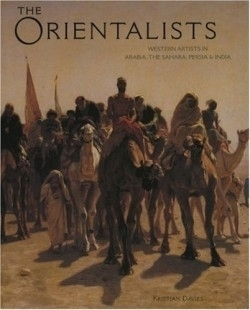The Orientalists
- 2005 INDIES Winner
- Editor's Choice Prize Nonfiction
“Orientalism,” the brilliantly colorful art of the 1800s that captured the exotic Orient in striking and fascinating detail, “is ripe for redefinition,” states the author, adding that the initiative requires “a delirious energy, a tangible, uncomplicated enthusiasm.” Possessing those qualities, he founded a press and has published a sumptuous book ablaze with reproductions of often spectacular Orientalist paintings. He is sparing with strictly academic analyses, but generous with engaging personal commentary and straightforward contextual pointers—and fully rewards his readers.
Some 300 images by seventy-five or so painters drawn from forty-five institutions in seven nations do not simply mean one more over-lavish “omnium-gatherum” coffee-table book. Davies’s subtitle defines his area: he states his preference for realism over heady imagination, emphasizes the later painters (post-1850 or so), and readily includes Americans (Bridgman, Mackenzie, and Vedder among them) and also interesting lesser-knowns such as Furlong, Hamdy-Bey, and Mønsted. He offers readers thirteen essays. Of these, seven focus on specific artists. The mighty Jean-Léon Gérôme we can expect, but Ilya Repin and Vassily V. Vereshchagin are unexpected plusses. Six essays focus on themes. We can anticipate Desert and Caravan and, of course, Women, but The Armed Guard and Faith are less predictable and indeed welcome.
The remaining essay is the bonus: Davies examines four “Orientalist” traveler-writers: Jean-Louis Burckhardt, Captain Richard F. Burton, Lady Jane Digby el-Mezrab, and Arthur Rimbaud. Because of their immense contributions to the West’s knowledge of the Islamic world, the lives of first two are well known, but the exotic (and erotic) journeyings of Lady Jane and the short, fraught, and absurdly tragic life of Rimbaud less so. In all cases, Davies’s well-illustrated vignettes (some featuring artwork by the subjects) fascinate; they will prompt many readers to explore available full-length biographies.
It is a tribute to the author’s organizing skill that what may appear as arbitrary essay topics reinforce each other, providing cohesion for this far-ranging work. His essay on Léon Belly and his dynamic masterpiece, Pilgrims Going to Mecca and the now-lost Fellaheen Hauling a Dabbieh demonstrate Davies’s solid grasp of composition, depicting musculature, backlighting techniques, and related matters. Similarly, he is no stranger to the broader reaches of art history, moving easily from Belly and Bridgman’s boat haulers on the Nile to those of Repin and Vereshchagin on the distant Volga.
“Uncomplicated enthusiasm” does not mean that Davies steers entirely clear of academic discourse. He takes up the cudgels against Edward Said’s strained polemic on the western invention of an “imagined Orient”—a polemic that fails to recognize that in the West curiosity was a driving a force that impelled legions of painters to record every visible aspect of the Oriental world—which exhibited pitifully little reciprocal curiosity. Davies also addresses tendentious writings of Linda Nochlin et al. against the depiction of near-naked women in harems and slave markets: to depict them was to record a reality, not to endorse a set of practices. (Interestingly, the magnificent bare male torsos and splendid limbs found in Orientalist painting do not appear to have aroused feminist ire.)
In giving theme precedence over chronology and in discussing the realities that the painters sought to capture, Davies effortlessly helps the reader see and experience the paintings more responsively. His commentary on Ludwig Deutsch’s Palace Guard opens readers’ eyes to the richness and variety of nineteenth-century arms and accoutrements and thus ties in these superbly crafted items’ distant sources of manufacture. In lifting the eye from the callipygian lad in Gérôme’s The Snake Charmer to the intricately patterned tiled wall behind his audience, Davies quietly alerts viewers to calligraphic panels as an element of Islamic architecture.
The inclusion-vs-exclusion problem bedevils every art historian. Davies thankfully spares readers the cascading breasts and mighty haunches of Ingres’s odalisques. Inclusion of Corrodi, Forcella, Peluso, and Von Meckel, to name only a few often neglected artists, is a plus, though some readers will regret omission of iconic works by Bonington, Chassériau, Delacroix, Vernet, and other revered masters.
All in all, this book (“an introduction,” as he modestly states) is a remarkable achievement for an author of only thirty or so. Less consciously academic than Philippe Jullian’s The Orientalists (1977), it is pictorially more appealing; less extensive than the seasoned Gérard-Georges Lemaire’s The Orient in Western Art (2000), which includes twentieth-century work, Davies’s book is nonetheless rich in historical and social commentary. Some incidental editing and expansion of reference material might have enhanced an already splendid book, but in any event Davies’s vitality and always-arresting images will exhilarate the reader. The Orientalists is a book to buy—and a copy lent will be a copy lost.
Disclosure: This article is not an endorsement, but a review. The publisher of this book provided free copies of the book to have their book reviewed by a professional reviewer. No fee was paid by the publisher for this review. Foreword Reviews only recommends books that we love. Foreword Magazine, Inc. is disclosing this in accordance with the Federal Trade Commission’s 16 CFR, Part 255.

